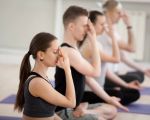- 1. How Yoga Helps Increase Energy and Vitality
- 2. The Physical Benefits of Yoga
- 3. How Yoga Boosts Mental Energy
- 4. Yoga Poses That Energize Your Body
- 5. The Science Behind Yoga and Energy
- 6. Creating a Daily Yoga Practice to Boost Vitality
- 7. How to Choose the Right Yoga Style for You
1. How Yoga Helps Increase Energy and Vitality
Yoga has long been known for its ability to promote relaxation and reduce stress. But did you know that yoga can also boost your energy levels and increase your overall vitality? By combining deep breathing, controlled movement, and mindfulness, yoga enhances your physical and mental well-being, which directly impacts your energy levels.
Whether you're a seasoned yogi or a beginner, yoga can be a powerful tool to help you feel more energetic and alive. In this article, we will explore how yoga increases energy and vitality, the specific benefits it offers, and how incorporating yoga into your routine can help you lead a more vibrant life.
2. The Physical Benefits of Yoga
Yoga is much more than just stretching; it is a full-body workout that helps improve strength, flexibility, and endurance. These physical benefits directly contribute to enhanced energy and vitality. By regularly practicing yoga, you can experience a wide range of improvements in your physical health:
2.1 Improved Circulation
One of the key ways that yoga boosts energy is by improving circulation. Many yoga poses increase blood flow to various parts of the body, ensuring that oxygen and nutrients are delivered to your muscles and organs. This enhanced circulation can help you feel more awake, focused, and energized throughout the day.
2.2 Strengthened Muscles
Yoga is known for its ability to build muscle strength through a combination of dynamic and static poses. Stronger muscles improve your posture and prevent fatigue, enabling you to have more stamina and energy. With regular practice, you'll notice that your body feels more resilient, less prone to strain, and better able to handle physical activity.
2.3 Increased Flexibility
Flexibility is another major benefit of yoga. The stretching and lengthening of muscles that occurs during yoga practice can help reduce stiffness and promote a feeling of lightness in the body. This increased range of motion reduces the physical discomfort that can drain your energy, making you feel more agile and ready to take on your daily tasks.
3. How Yoga Boosts Mental Energy
Yoga is not only beneficial for your physical health but also has a profound effect on your mental energy. Through techniques like mindful breathing and meditation, yoga helps clear the mind and foster mental clarity. Here's how:
3.1 Stress Reduction
One of the primary ways that yoga increases vitality is by reducing stress. Chronic stress is a major energy drain and can leave you feeling exhausted both mentally and physically. Yoga activates the parasympathetic nervous system, which promotes relaxation and counteracts the negative effects of stress. With regular practice, you'll experience a calmer mind and greater resilience to life's challenges.
3.2 Improved Focus and Clarity
Yoga encourages mindfulness, which helps you stay present in the moment and enhances your ability to focus. As you practice yoga, you learn to quiet the mental chatter, allowing you to experience greater clarity and a sense of inner peace. This focused mental state translates to increased energy, as you're no longer wasting mental energy on distractions or anxiety.
3.3 Enhanced Emotional Well-Being
Yoga fosters emotional well-being by encouraging a positive mindset. Many yoga practices incorporate affirmations and meditative elements that promote self-love, gratitude, and emotional balance. By improving your emotional health, yoga helps you feel more energized and motivated, reducing feelings of fatigue caused by negative thoughts or emotional stress.
4. Yoga Poses That Energize Your Body
While all yoga poses contribute to overall vitality, some poses are particularly effective at boosting energy levels. These poses stimulate blood flow, release tension, and revitalize your body. Here are a few yoga poses known for their energizing effects:
4.1 Downward-Facing Dog (Adho Mukha Svanasana)
Downward-facing dog is one of the most energizing yoga poses. This pose stretches the entire back and legs, improves circulation, and stimulates the nervous system. By inverting your body and elongating the spine, this pose helps release tension and rejuvenates the body, making you feel more awake and alert.
4.2 Warrior Pose (Virabhadrasana)
Warrior pose is a powerful standing posture that strengthens the legs, opens the hips, and builds mental focus. By engaging the muscles of the lower body and extending the arms, this pose energizes the body and helps increase stamina. It also improves posture, making you feel more grounded and confident.
4.3 Camel Pose (Ustrasana)
Camel pose is a backbend that opens up the chest and lungs while stimulating the heart and improving circulation. This heart-opening pose not only enhances physical vitality but also helps alleviate stress and emotional tension, leaving you feeling uplifted and energized.
5. The Science Behind Yoga and Energy
The science behind yoga’s impact on energy and vitality can be explained through its effects on the nervous and endocrine systems. Yoga has been shown to increase the production of endorphins (the body’s natural mood elevators) while reducing cortisol (the stress hormone). This hormonal balance boosts both physical and mental energy, allowing you to feel more vibrant and rejuvenated.
5.1 Yoga and the Autonomic Nervous System
Yoga stimulates the parasympathetic nervous system, which promotes relaxation and recovery. By practicing controlled breathing and relaxation techniques, yoga helps lower heart rate, reduce blood pressure, and regulate stress hormones. This leads to improved energy levels and vitality as the body operates more efficiently.
5.2 Breathing and Energy Production
Deep breathing is an integral part of yoga practice and is linked to increased oxygen intake, which enhances energy production at the cellular level. By focusing on pranayama (breathing techniques), you increase oxygen flow to the brain and muscles, leading to greater mental clarity and physical vitality.
6. Creating a Daily Yoga Practice to Boost Vitality
Incorporating yoga into your daily routine is one of the most effective ways to boost energy and vitality. By practicing regularly, you can enjoy the long-term benefits of increased strength, flexibility, and mental clarity. Start with just 10-20 minutes a day and gradually increase your practice as you become more comfortable.
6.1 Setting Intentions
Begin each yoga practice by setting an intention to cultivate energy and vitality. This could be a specific goal, such as staying focused throughout your day, or simply an intention to feel more balanced and refreshed after your practice.
6.2 Building a Consistent Routine
Consistency is key when it comes to yoga. Set aside time each day for your practice, whether it’s in the morning to start your day with energy or in the evening to unwind and recharge. Over time, you’ll notice a significant improvement in both your physical and mental vitality.
7. How to Choose the Right Yoga Style for You
Different styles of yoga offer various benefits. For boosting energy and vitality, styles like Vinyasa, Power Yoga, or Ashtanga are dynamic and flow-based, providing an excellent workout while keeping you engaged. If you prefer a gentler approach, Hatha or Yin Yoga can help restore balance and rejuvenate your body without excessive exertion.
To explore the best yoga classes and resources for energy and vitality, visit Free Yoga Links for helpful guides, classes, and recommendations.








